1lumen selects and reviews products personally. We may earn affiliate commissions through our links, which help support our testing.
Nitecore TM20K Review
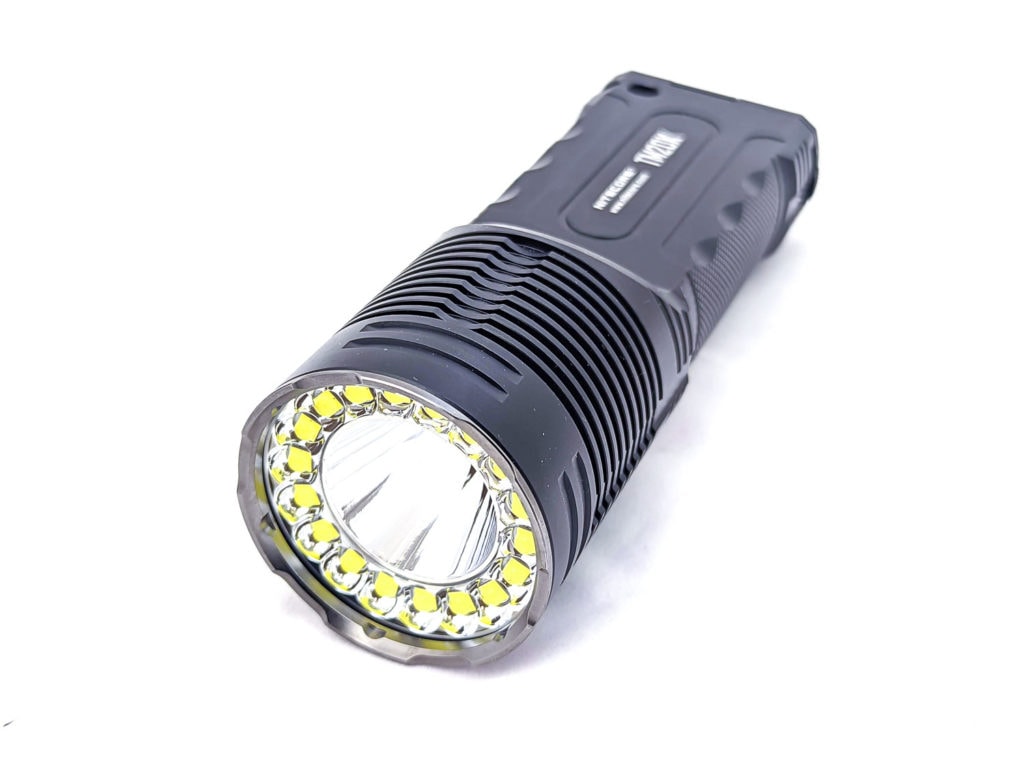
Nitecore TM20K specifications
| Brand/model | Nitecore TM20K |
|---|---|
| Category | Brightest tactical flashlights |
| LED | 19 * CREE XP-L2 |
| Max. Lumens | 20,000 lm |
| Max. Beam intensity / distance | 290m / 22,200 cd |
| Battery config. | Non-removable 2*21700 |
| Onboard charging | USB-C |
| Modes | 7 |
| Blinkies | Strobe (possibly) |
| Reflector | Smooth |
| Waterproof | IP68 |
| Review date | March 2022 |
Introduction:
The TM9K is 9000 lumens, TM10K is 10,000 lumens. You don’t have to read the manual to know that the TM20K is going to be a massive 20,000 lumens!
This is a pretty exciting light. Nitecore have been known for making high-quality flashlights for over a decade and their “TM” range has been around for almost as long. In fact, I remember seeing their TM03 flashlight years ago and thinking how incredibly bright 3000 lumens in a handheld light would be.
The TM20K is extra special. Not just because of the astounding lumen rating but also because of its size and form factor. It follows in the footsteps of their EC4, which used 2 cells next to each other, which fills the gap between more pocketable single cell lights and much bigger soda can or soup can style lights.
Not only that but the TM20K has different sized reflectors for both flood and throw. This is a very cool flashlight.
The most similar flashlight I know of is the Fenix LR35R, which is half as bright at 10,000 lm.
Package quality.
You get more than just a plain cardboard box with Nitecore. Well, you will anyway. I received the TM20K for review before they had finalized the packaging.
Mine came with:
- Nitecore TM20K flashlight (with built in battery pack)
- USB-C cable
- Lanyard
- Holster
The retail version would more than likely come with a manual, warranty info and possibly other accessories.
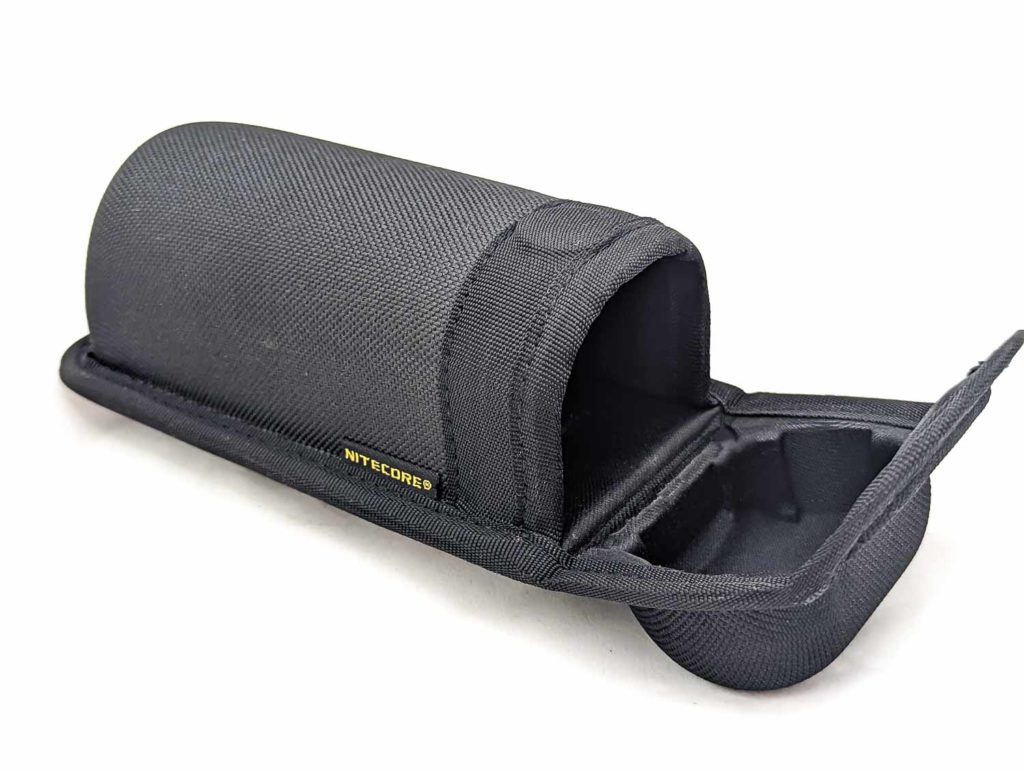

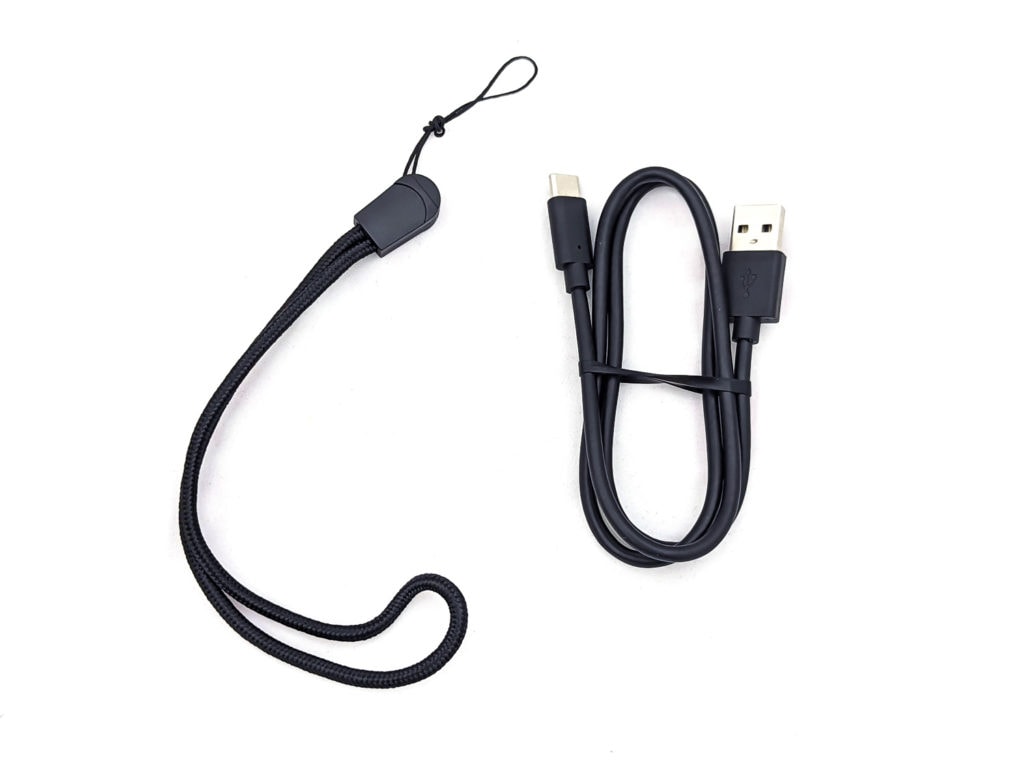
Flashlight in use
Even before picking it up, it’s clear the Nitecore TM20K is a bit different due to the shape. I don’t think I have any other rectangular flashlights and the shape will stand out in any collection.
The TM20K is one solid chunk of metal. It’s fairly heavy and feels very well built. The rectangular shape means it’s easier to grip than a light with 3 cells.
The 3 switches are all at the tail end, so the TM20K is designed to be carried with your thumb at the end and your pinky towards the head. I normally prefer side switches but the switch positions Nitecore have picked make good sense for its intended use. You can actually carry it cigar-grip style, using the clip for extra grip, though it’d get heavy after a while.
The clip is probably the strongest I’ve seen. It’s also the only multi-cell flashlight I have that comes with a clip. The TM20K fits fine in my jeans pocket, though is a bit chunky. The clip can be removed with a torx driver.
Nitecore provides 2 other ways of carrying it: either with the lanyard or the nylon holster. The flashlight goes in head down in the holster and stays put due to friction and the magnetic cap. The holster is actually much firmer than most, providing very good protection to the light.
The TM20K will head stand, tail stand and stay put when lying sideways, thanks to its flat surfaces.
The light is clearly designed for tactical use, using 1 of the main modes the bulk of the time, then occasionally jumping to the blinding 20,000 lumens for a few seconds at a time. Although it’s designed for military, law enforcement, security, etc, there’s nothing stopping you taking it on a gentle walk with your dog at night or leaving it on ultralow for a few hours whilst camping. One thing it’s certainly bad for is finding your way to the bathroom at night, as even ultralow is 320 lumens and you’ll probably have to cycle through high modes to get to it.
This many lumens in a small size means the light doesn’t throw a long way. This light is all about lighting up all around you very brightly and can’t really be used for slowly sweeping across the horizon, looking for animals or hidden paths.
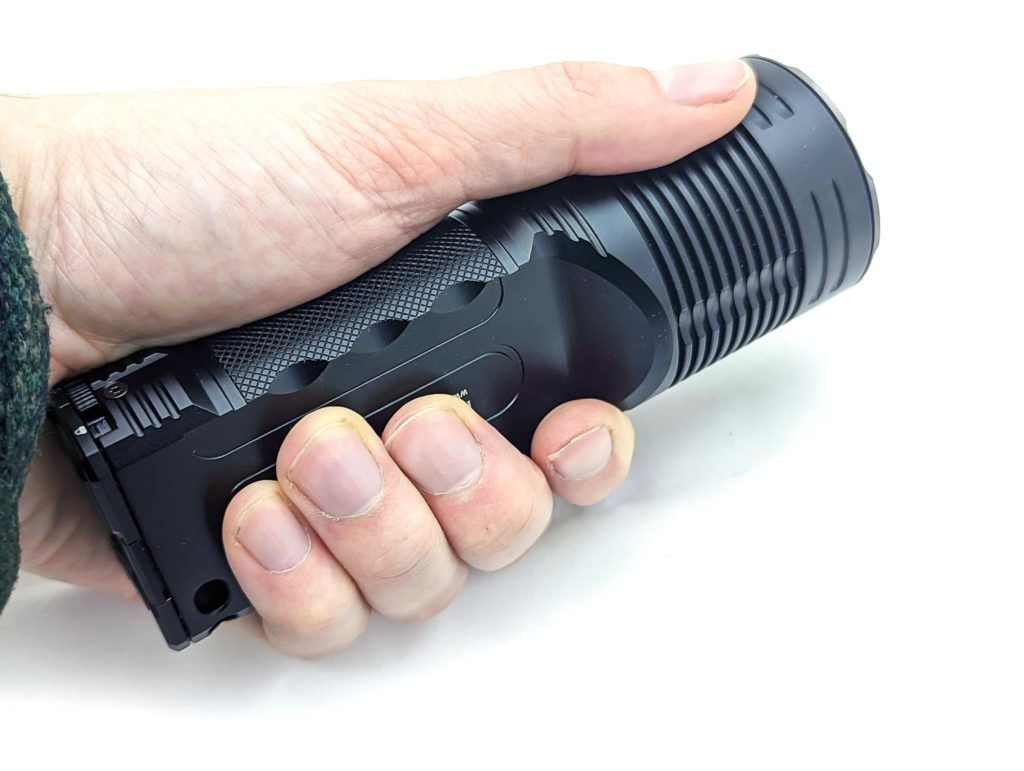
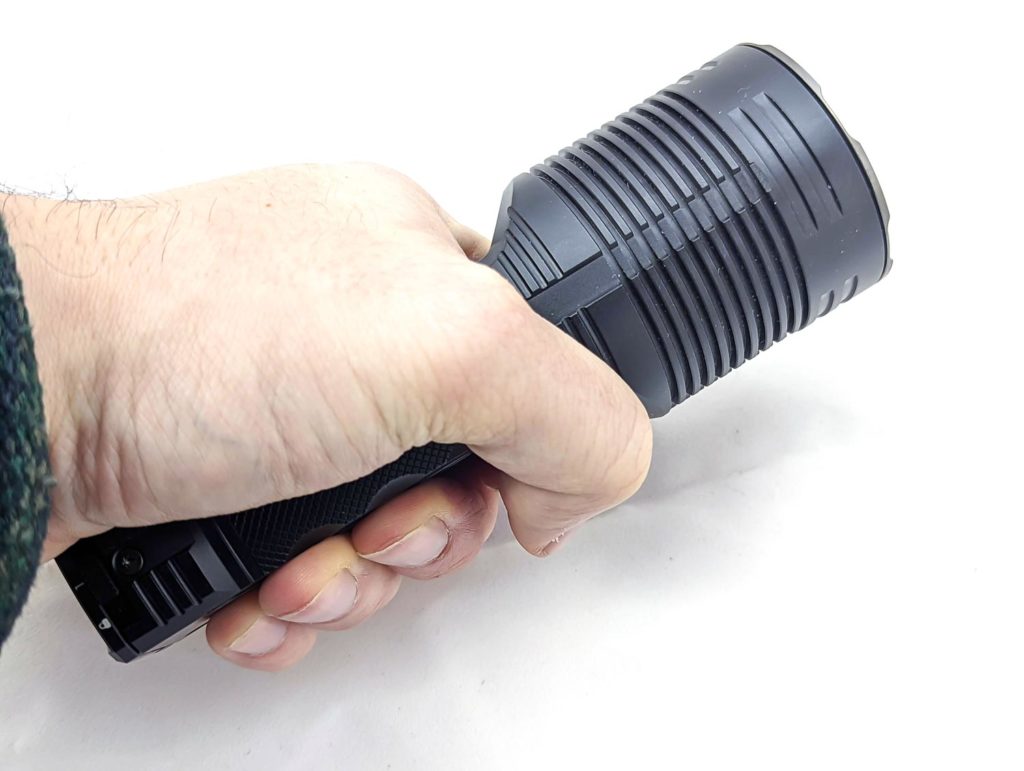
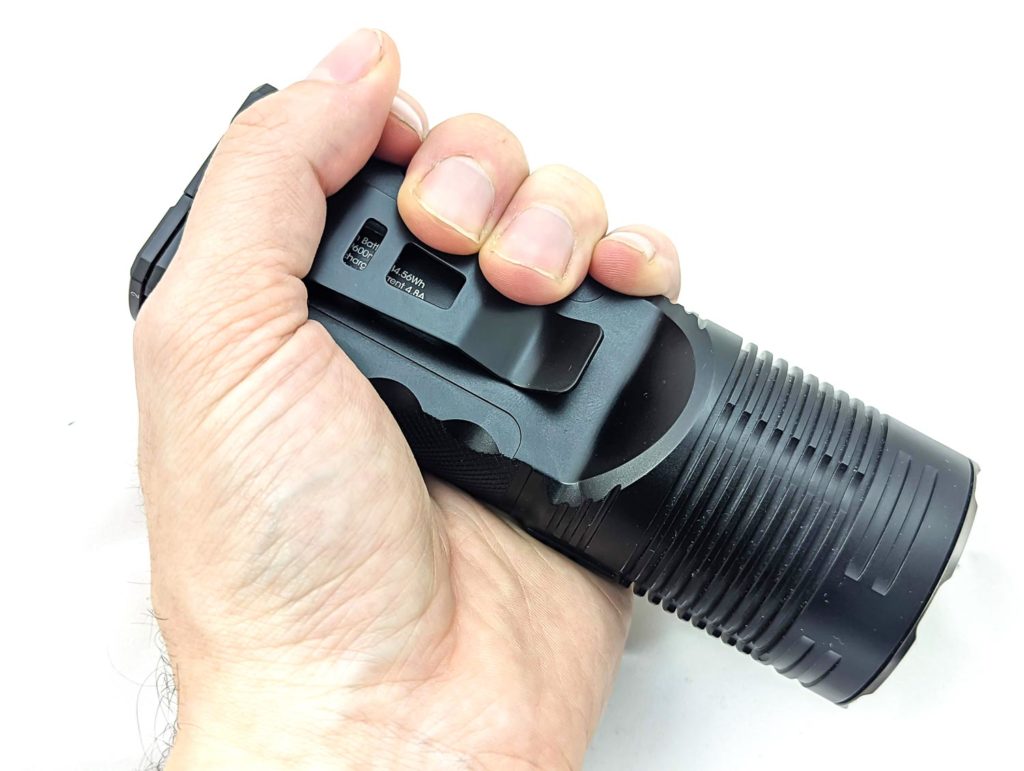
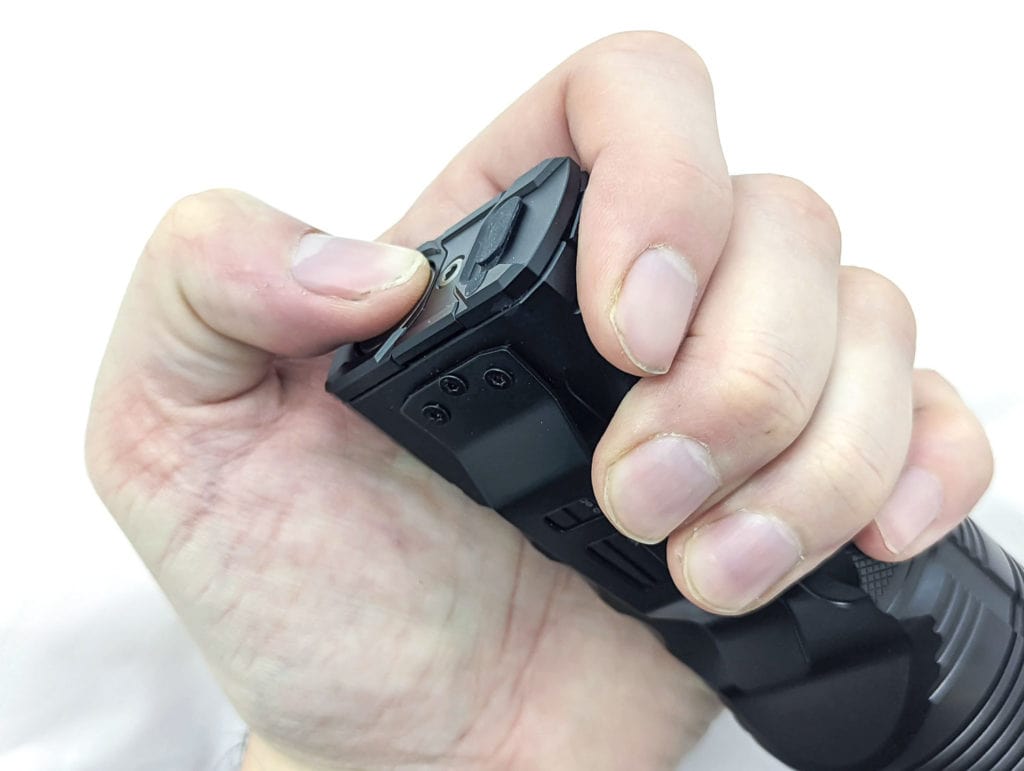
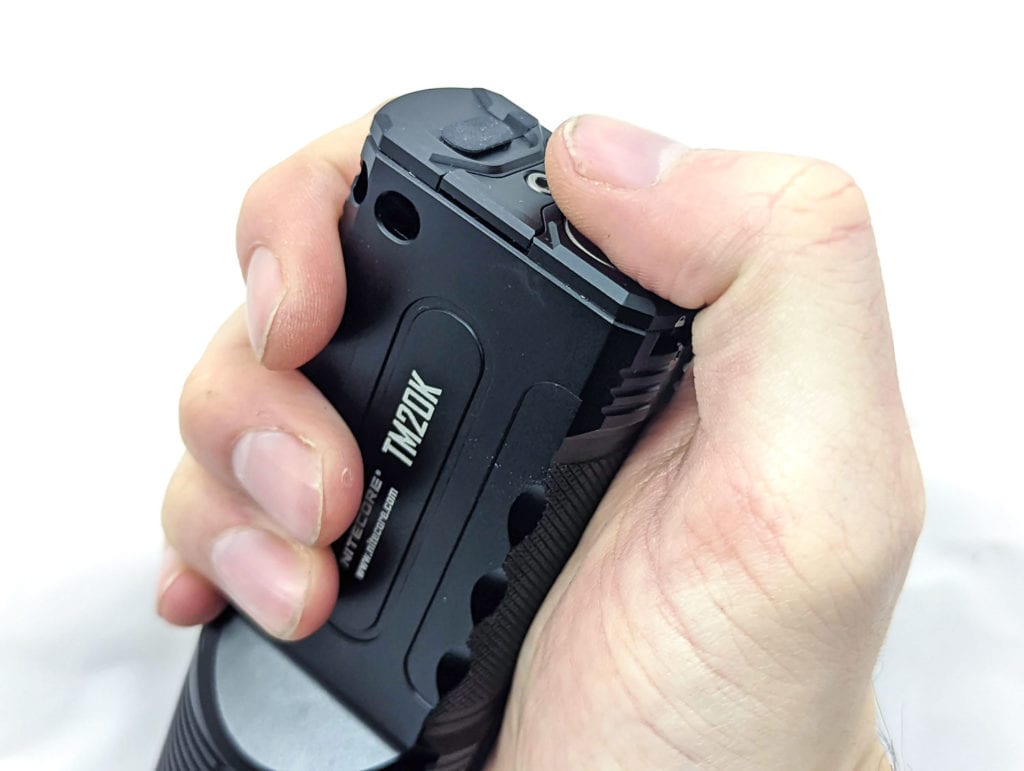
Build Quality, and Warranty
No complaints here. The single block of metal makes the TM20K one of the most robust feeling lights I have. I’d put the Nitecore alongside the likes of Olight and Acebeam when it comes to build quality.
There’s knurling on the shorter sides of the body and they’re curved for a more comfortable grip. There’s no threads to get to or any insides to take a peek at but I trust that Nitecore have done a good job.
The TM20K has a built-in battery pack, so unfortunately that means that Nitecore’s warranty only covers you for 2 years. Beyond that, you get a limited lifetime warranty where you only pay for parts. This should cover any faults but to be honest I don’t know what would happen if the battery pack started to lose its capacity after 5 or 10 years. Though by that time I wouldn’t be surprised if you could get a TM80K anyway.
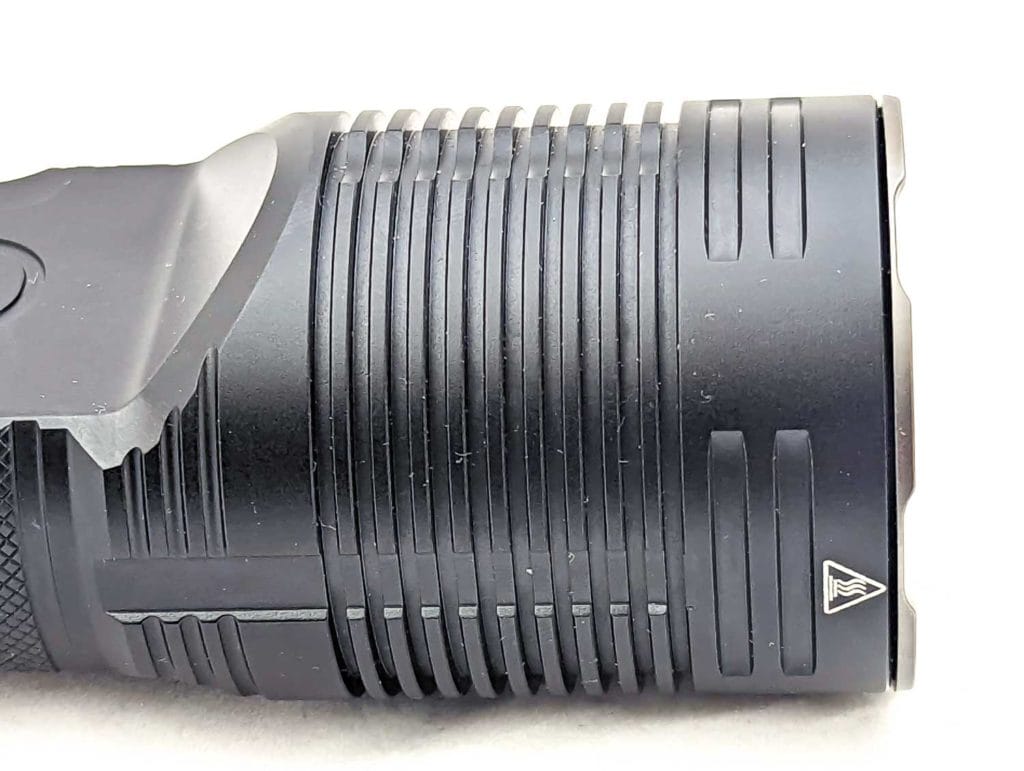
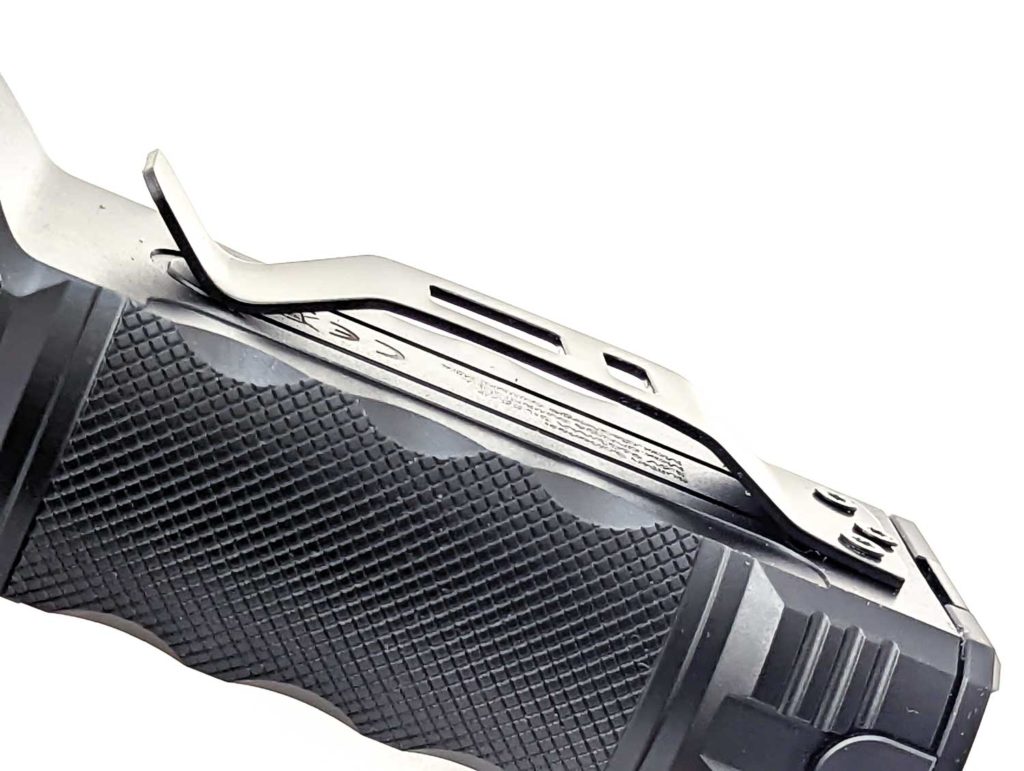
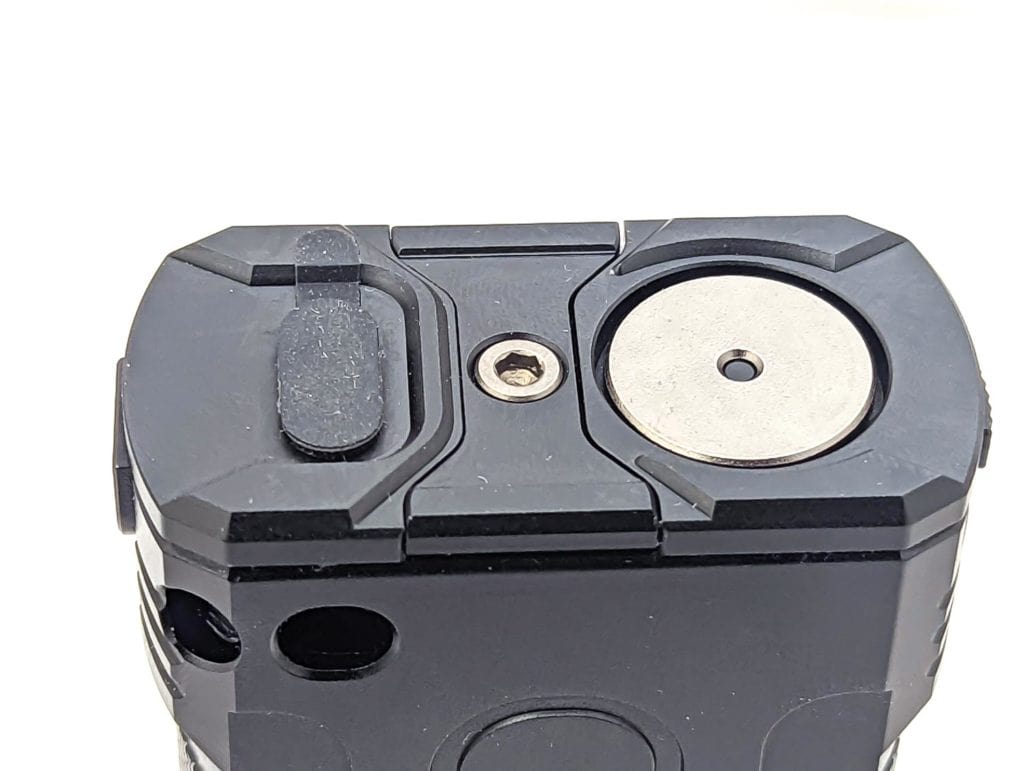
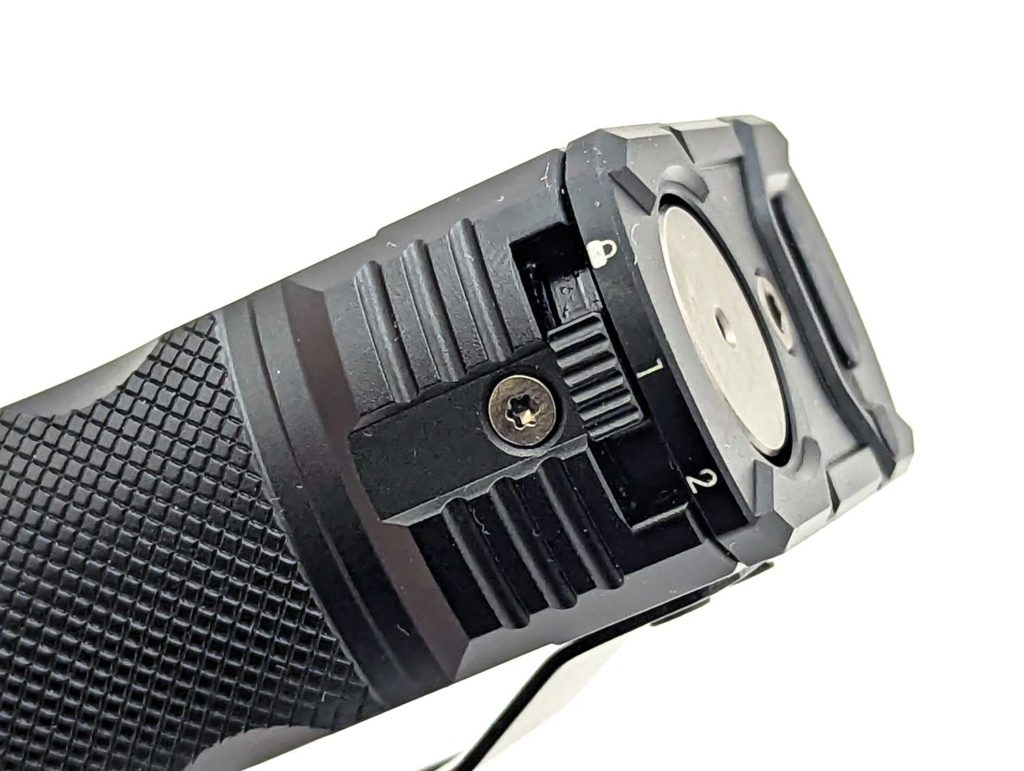
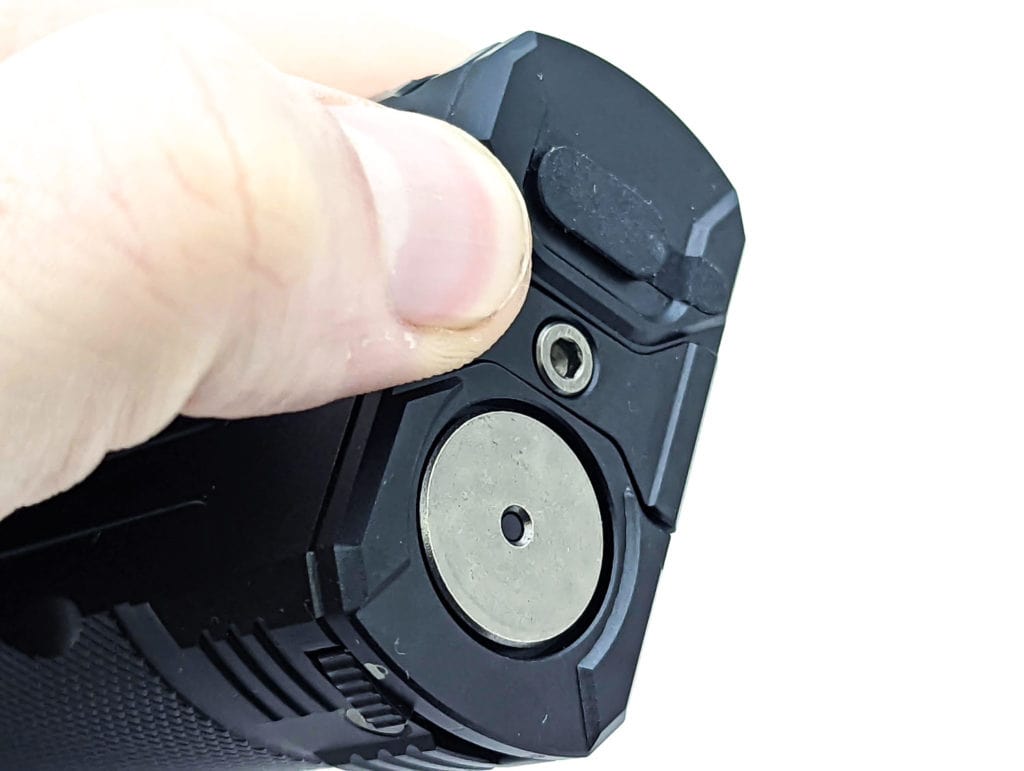
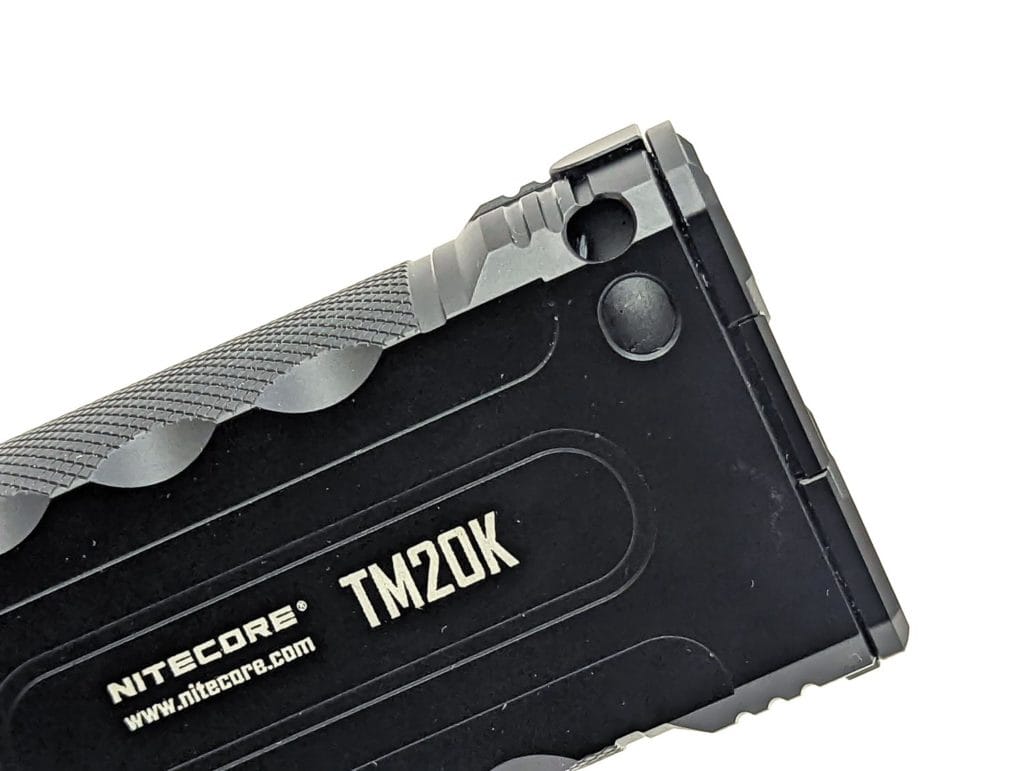
LED, Lens, Bezel, Beam, and Reflector
Nitecore have crammed 19 LEDs into the TM20K. That means each one produces just over 1000 lumens – something that’s fairly standard in flashlights these days.
The light is set up with 1 big reflector in the middle for throw, surrounded by 18 for flood. This flood and throw combo is similar to a few other lights, like the Acebeam X10, Olight Marauder 2 and upcoming lights from Intl-outdoor and Wurkkos.
You’d expect the center LED to be specially picked for throw, like an Osram W1. But no, Nitecore has picked CREE XP-L2 LEDs for all the LEDs, including the center one. XP-L LEDs are 3535 size and 3V, which makes the electronics easier. These are bright LEDs but not the brightest for their size.
These are very cool CCT LEDs.
- CCT: 6532K
- CRI Ra 71.0
- DUV: 0.0002 (center of the beam)
Unfortunately there’s a bit of a “CREE rainbow visible. Though if you’re considering the TM20K then quick access to lots of lumens is going to be more important than a beautiful light output.
The big reflector is about 30mm across. The 18 tiny reflectors are barely actually reflectors as the LEDs are 2 or 3mm away from each other. This means the LEDs can be seen at close to 180 degrees and are virtually pure flood.
Most of the modes use the spot and flood LEDs, with ultralow and spotlight modes only using the center one and the floodlight mode only using the outer ones.
The candela per lumen gives an idea of how floody or throwy the beam profile is. Spotlight is 14 cd/lm, which is similar to my Astrolux FT02S and Emisar D4SV2. The spotlight by itself only goes to 1200 lm and 260m throw though, so don’t expect to use spotlight mode like a pocket thrower. Floodlight by itself is just 0.7 cd/lm, which is close to a mule flashlight. As you go up from low to turbo, the TM20K gets gradually more floody, as more current goes to the outer LEDs.
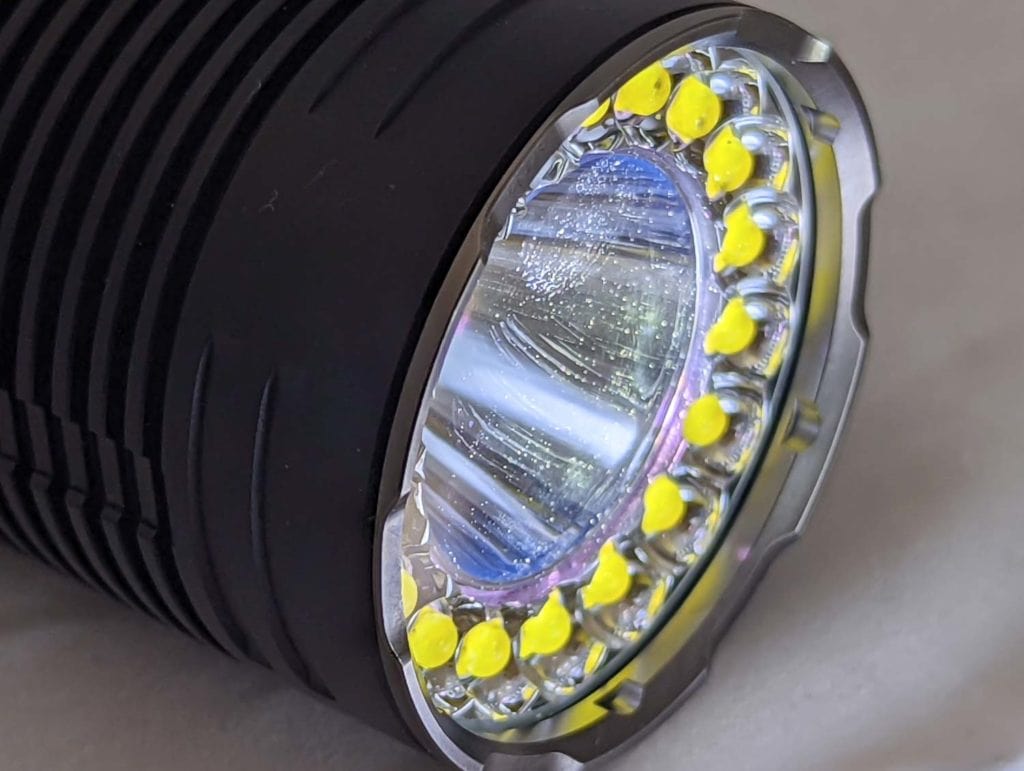

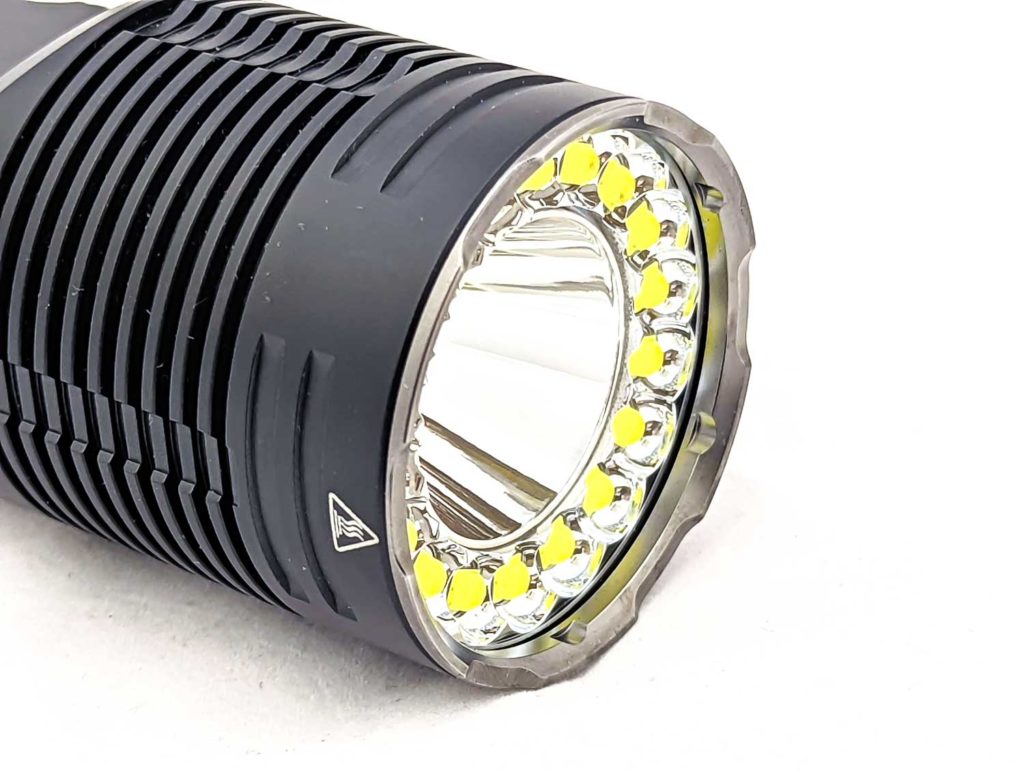
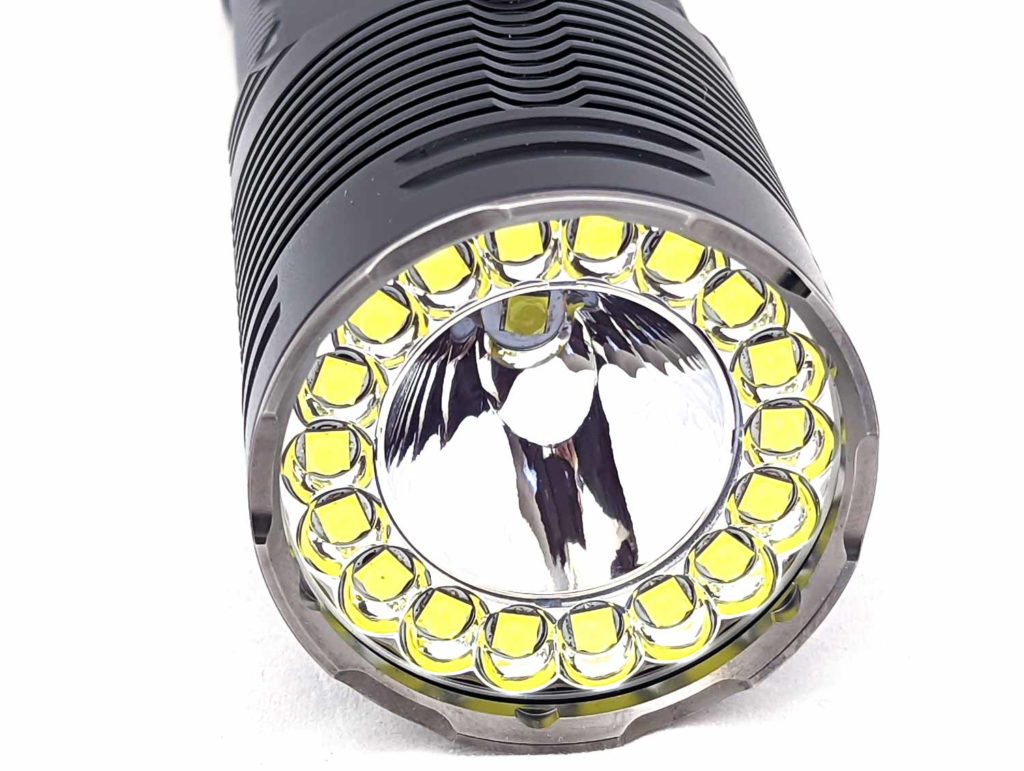
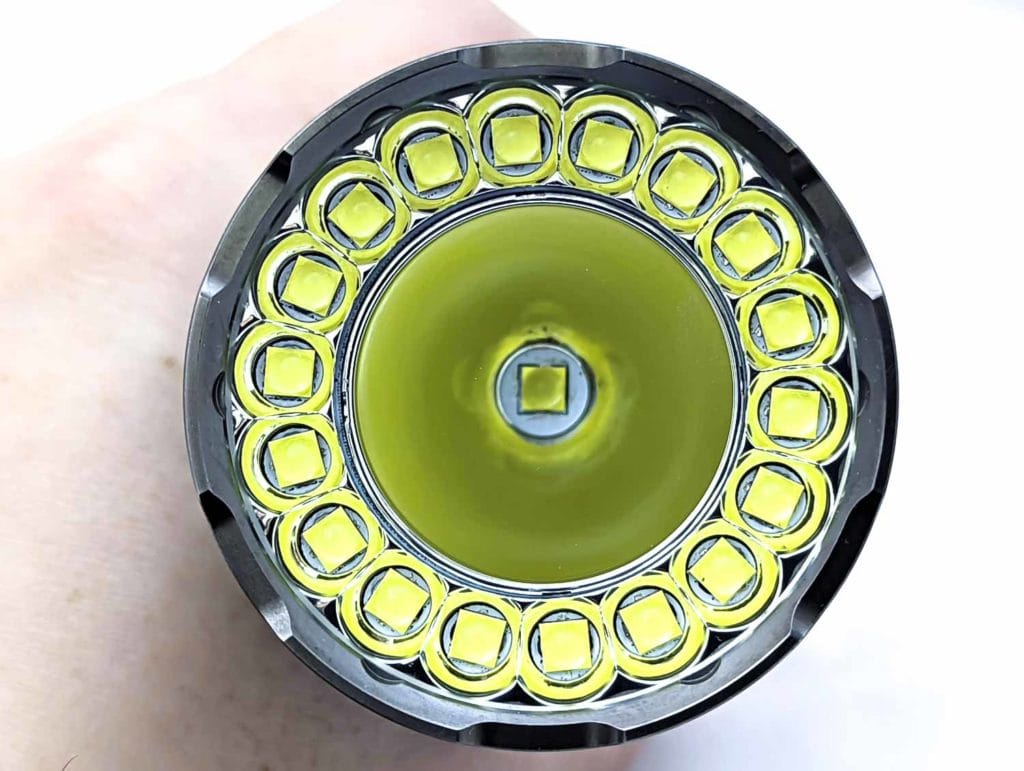
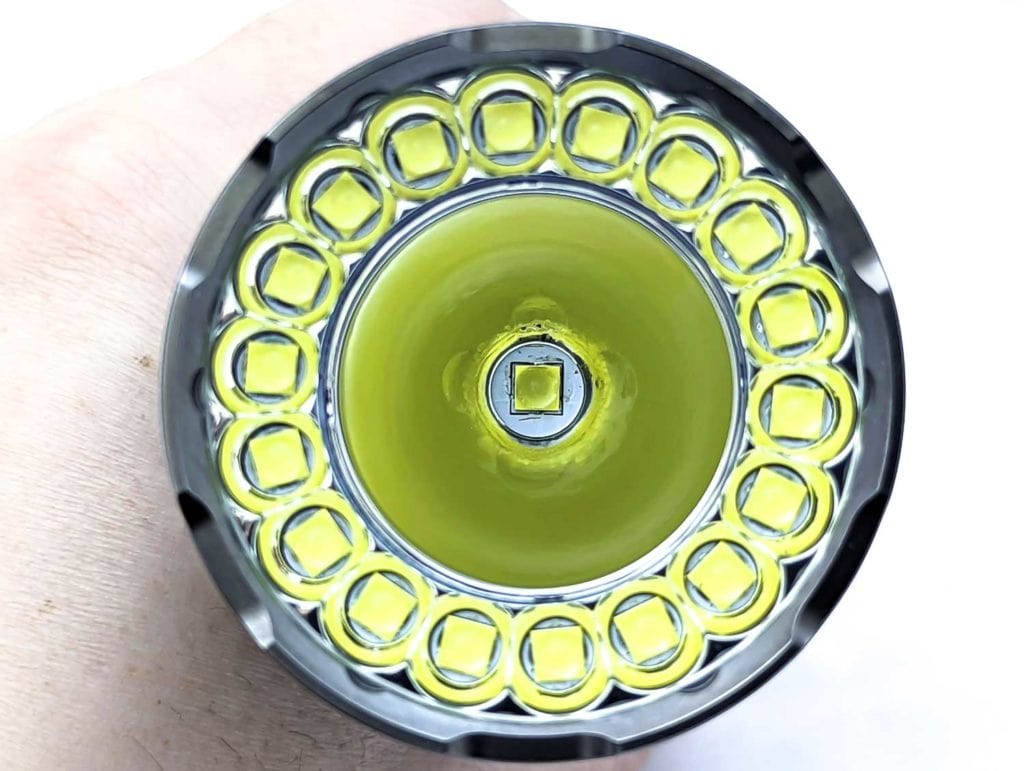
Dimensions and size comparison
- Length: 14.55 cm / 5.73 inches
- Head diameter: 5.01 cm / 1.97 inches
- Body diameter (wide): 5.01 cm / 1.97 inches
- Body diameter (narrow): 2.60 cm / 1.02 inches
Weight:
- With battery pack: 422 grams / 14.89 oz.
Tactical Flashlight comparison
Size compared to other normal and tactical flashlights
From left to right:
- Acebeam K30-GT
- Sofirn SP36
- Nitecore TM20K
- Convoy M3-C
- Astrolux FT02S
- Armytek Viking Pro

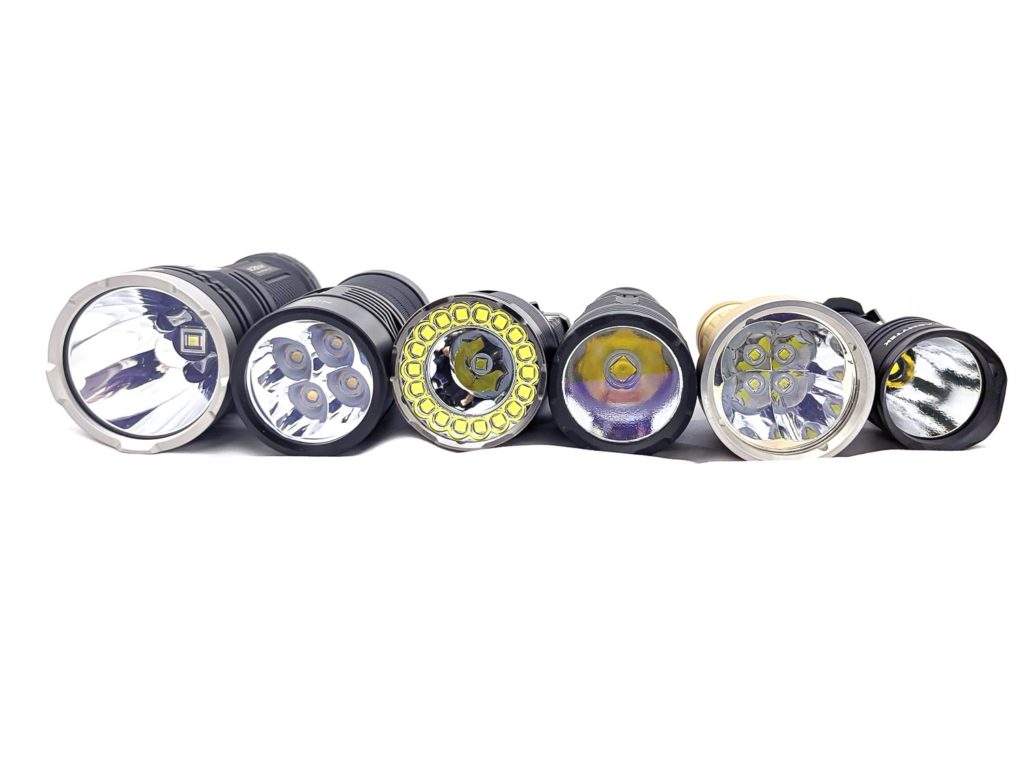
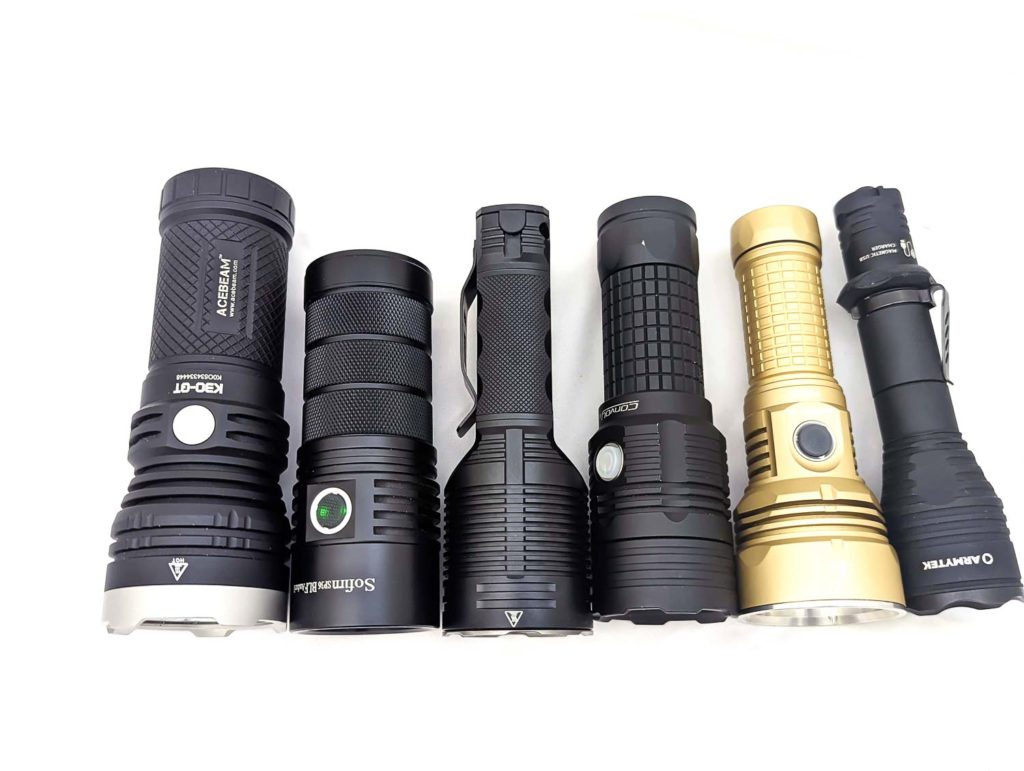
Driver & User Interface:
The TM20K has 4 switches. But don’t panic, it’s very quick and easy to learn and get used to.
First of all, the big round metal power button. This turns the light on and off, using the last mode you used. Simple.
Next, there’s the sliding toggle switch. This allows you to pick from:
- lockout mode: the light won’t turn on. Recommended for carrying in a pocket or the holster
- Note: Nitecore has updated lockout mode in production flashlights to make it safer. Now it locks the same way but unlocking requires holding the mode button at the same time as moving the toggle switch.
- daily mode (1): each press of the power button turns the light on or off. If you’re not sure then pick this one.
- tactical mode (2): the light only turns on while you hold the power button. This is a momentary mode, useful for signaling.
Here comes the fun one: the tactical button! Holding down this will turn the light on straight to the 20,000 lumen turbo mode. You can tap the button quickly to signal or hold it for a couple of minutes if you really want to. The tactical button always works the same way and isn’t affected by switching between daily and tactical modes – it’s only affected by lockout mode, which stops it working. As you’d expect, you can activate turbo mode whilst the light is on in a normal mode too. The tactical button is actually a 2-sided rocker switch, so you can press to either the left or the right.
Nitecore’s marketing information lists this button as activating strobe too but I haven’t figured out how to do that as I don’t have the user manual. I’m pretty sure that there isn’t a dedicated strobe mode or if there is then it’s not easy to access.
Lastly, there’s the mode button. This changes brightness and can the proportion of spot vs flood. When the light is on then tapping the mode button changes brightness. Holding the button allows you to access the special floodlight and spotlight modes.
What’s a bit unexpected is that the spot light doesn’t seem to get brighter throughout the normal modes – only the flood ones do. Here’s a table, based on a rough guess by eye and what would make sense for the driver, which should show what I mean.
| Mode | Total lumens | flood lumens | spot lumens | Spot percentage |
| Spotlight | 1,200 | 0 | 1,200 | 100% |
| Floodlight | 1,800 | 1,800 | 0 | 0% |
| Ultralow | 320 | 0 | 320 | 100% |
| Low | 1,050 | 730 | 320 | 44% |
| Mid | 1,900 | 1,800 | 320 | 17% |
| High | 3,100 | 2,600 | 320 | 10% |
| Turbo | 20,000 | 19,000 | 1,000 | 5% |
Available modes: Ultralow, Low, Medium, High, Turbo
From off:
- Click power button: on (mode memory)
From on:
- Click power button: of (mode memory)
- Click mode button: change brightness
- Hold mode button for 2 seconds: change to floodlight only mode
- Hold mode button for 4 seconds: change to spotlight only mode
Mode memory:
- Yes
Shortcuts:
- Special turbo button
Low voltage warning:
- The light will step down and turn off at low voltage
Strobe/blinkies
- None found
Lock-out mode:
- Yes, with the toggle switch
PWM
- I could detect PWM on some lower modes with a camera but not by eye
Batteries & Charging
Inside the Nitecore TM20K, there’s a battery pack that uses 2* 21700 cells. You can’t get access to this without voiding the warranty. Nitecore lists these as 4800mAh capacity. These should last a good long time but as they’re not user-replaceable, you have to send the light back to Nitecore or dispose of it if they ever fail. I can see why they did this (safety, better current path, cost, etc) but in my books, it’s worse than having to buy expensive proprietary cells.
Having a fixed battery pack means the TM20K comes with built-in charging. This is via the USB-C port in the tail end and covered by a rubber boot.
The light charges in 4.5 hours according to Nitecore. This seems about right, as after a run time from empty, it took about 4 hours 40 minutes to get to the point where it was trickling current into the cells. The TM20K does this thanks to the QC charging. It fast-charged at 12V 1.4A, just short of 18W.
The light also has a blue power indicator LED in the middle of the power button. This is on when the light is on and the cells have lots of capacity left. When the cells get low then the indicator starts flashing.
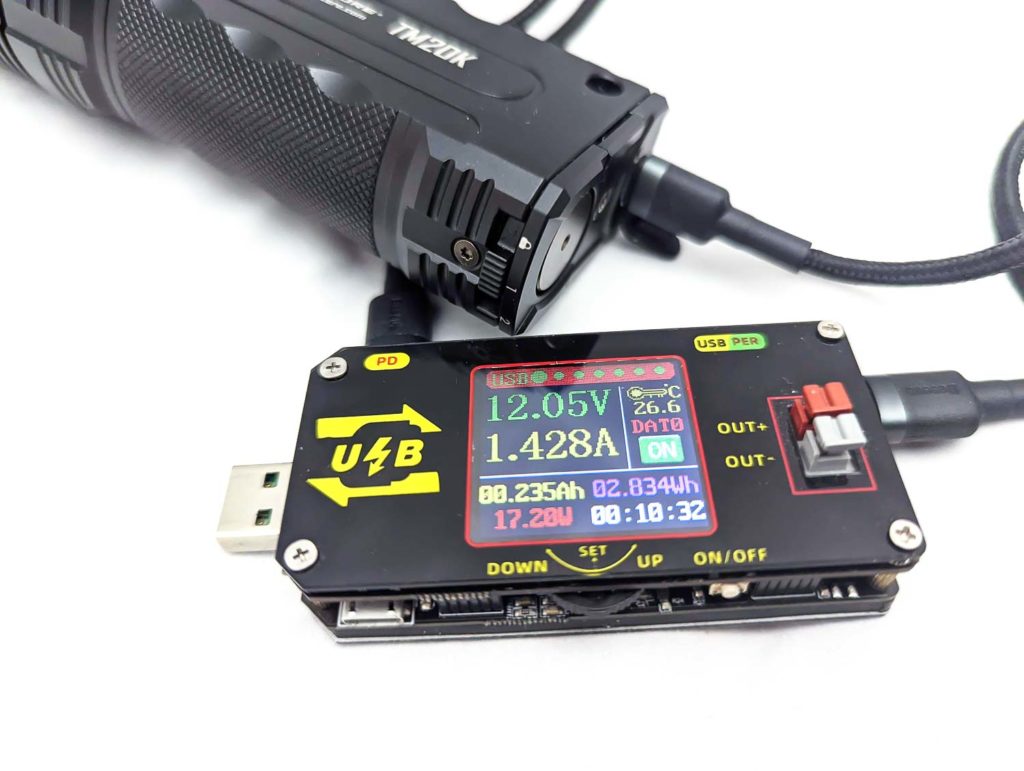
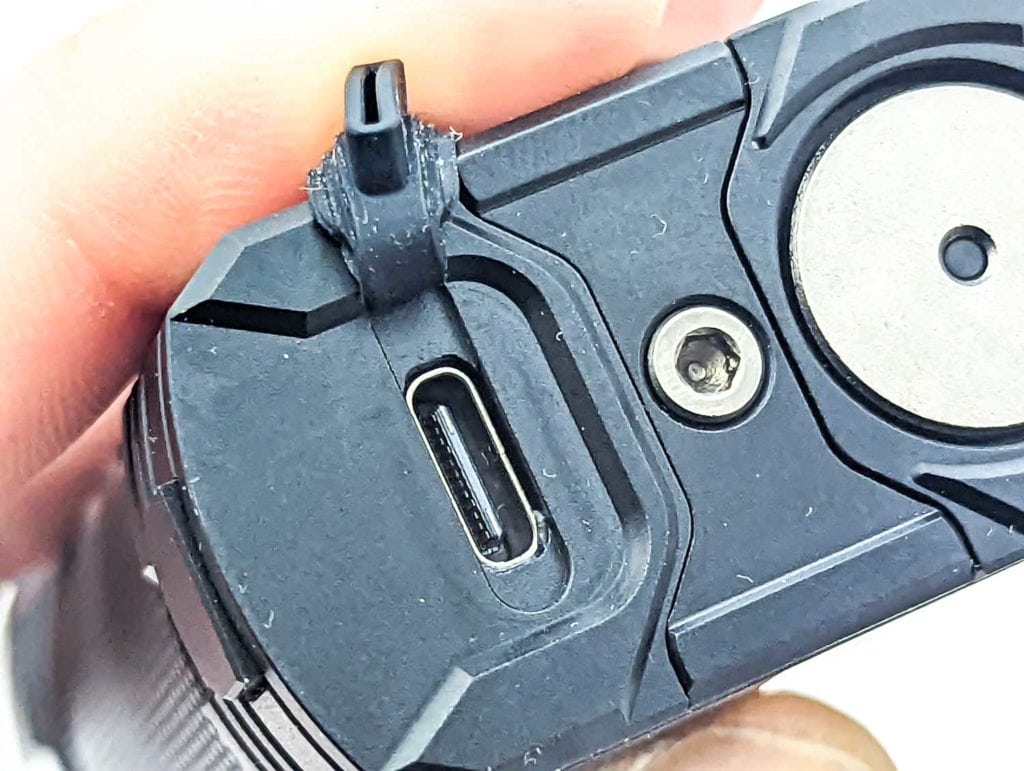
Performance
Lux meter: All lux and lumen measurements are from my home made integrating sphere, calibrated with a S2+ measured by Maukka. Measurements are done with a UNI-T UT383S lux meter and Adafruit TSL2591 connected to a Raspberry Pi (using RuTiTe by bmengineer). Expect them to be within +/-10%.
DMM: Current readings were taken with a Precision Gold PG10B DMM for low currents and a Mustool X1 clamp meter for high currents.
Lumen measurements (for each mode)
Nitecore’s numbers are generally pretty close here. It consistently hit over 18,000 lumens on turbo, with some measurements hitting 19,000. One time I saw it hit 20,000 lumens but I’d moved the light slightly, so it could have been an error. Either way, it’s within 10% of the claim and very very bright.
| Mode | Specs | turn on | 30 sec | 10 minutes |
|---|---|---|---|---|
| Ultralow | 320 | 294 | 293 | 292 |
| Low | 1050 | 899 | 892 | 877 |
| Med | 1900 | 1771 | 1727 | 1648 |
| High | 3100 | 3220 | 3121 | 874 |
| Turbo | 20,000 | 18,167 lm | 3105 | – |
| Spotlight | 1200 | 1193 | 1172 | – |
| Floodlight | 1800 | 2032 | 2001 | – |
Parasitic drain:
- Unable to measure
Runtime graph
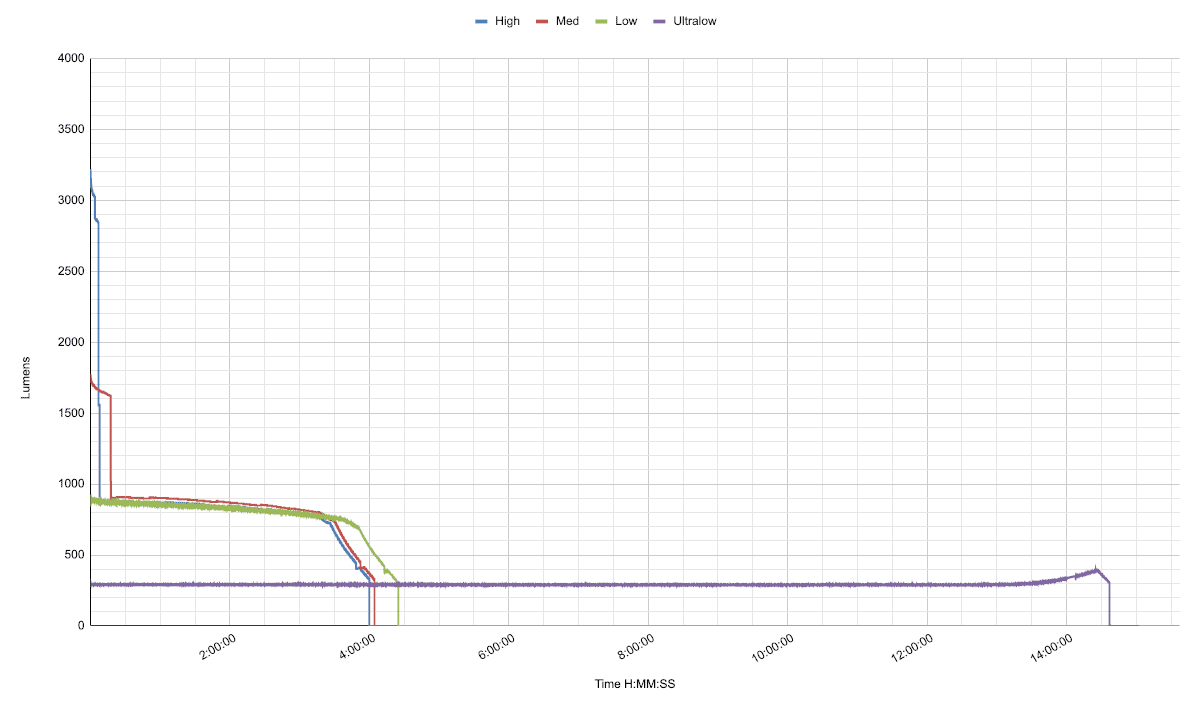
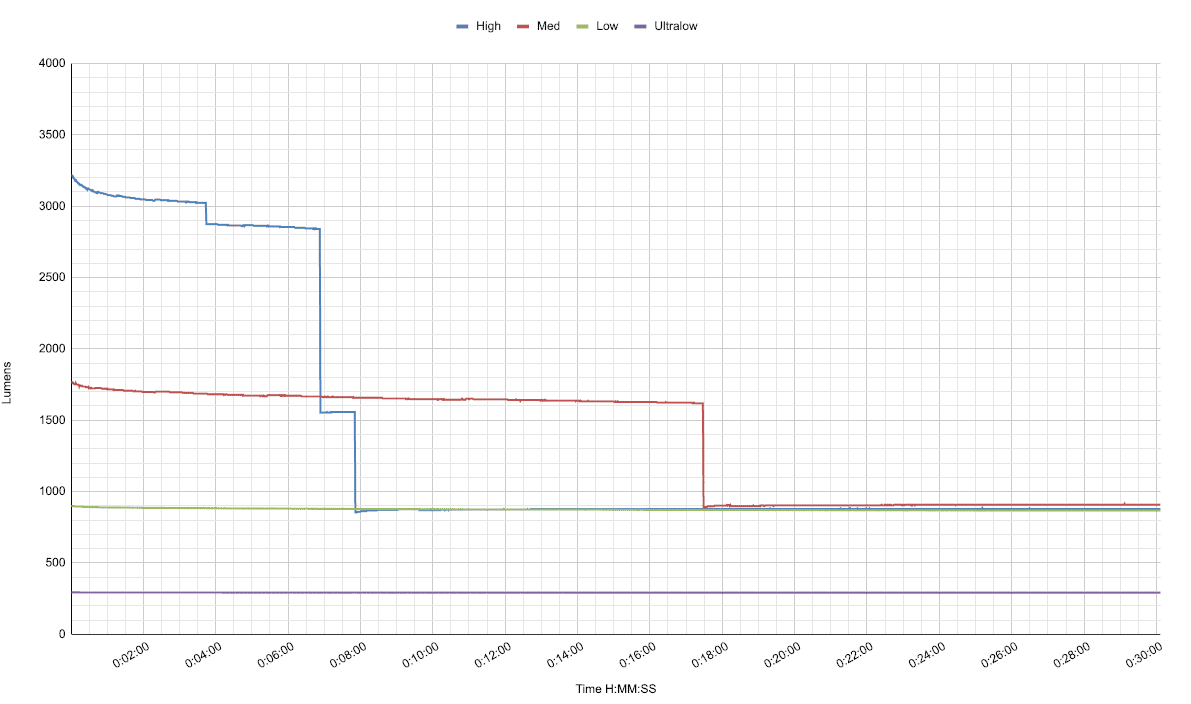
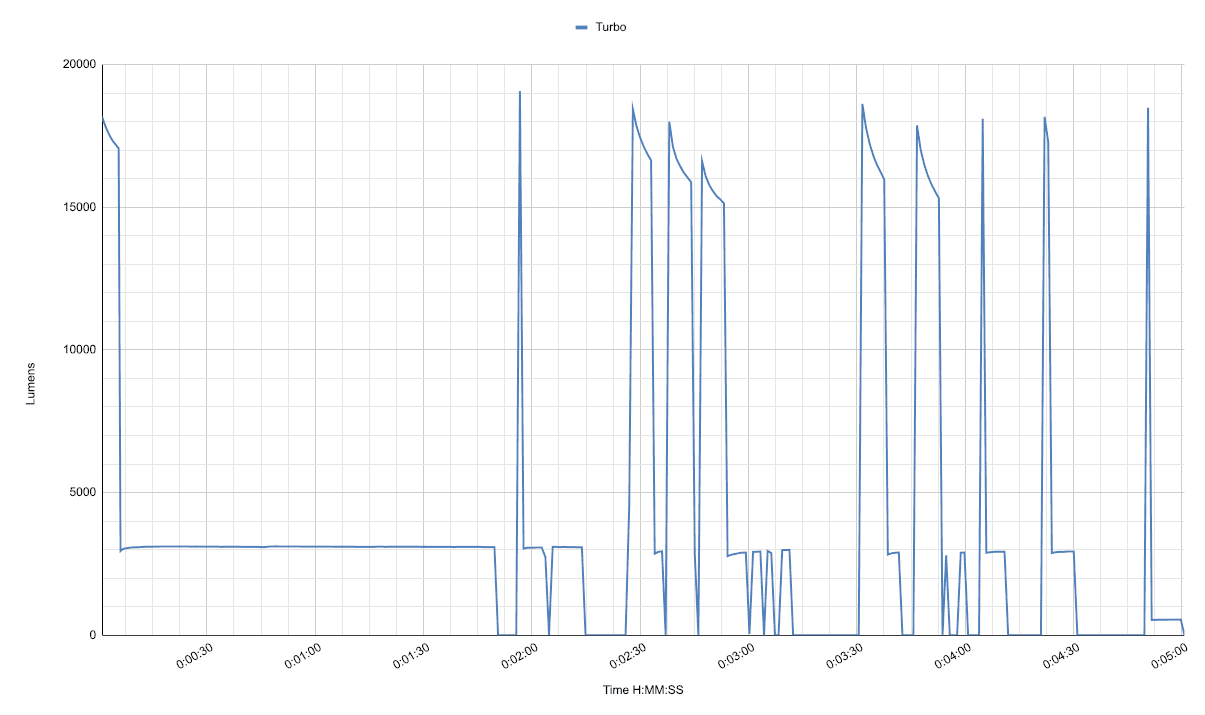
Let’s get this out the way first: turbo lasts 5 or 6 seconds before dropping to around 3000 lumens. After waiting a 5-10 seconds it will do another burst of turbo. If you try to reactivate it too soon then it will either only last 1 second or won’t go above 3000 lumens. This is kind of what I’d expect, as the TM20K follows the same rules of thermodynamics as everything else in the universe. Nitecore could have let turbo last a little longer but then the TM20K would get too hot to hold. It got up to about 45 to 50°C with normal turbo and high usage and I managed to get it up to 65°C at the head when manically trying to get it to go to turbo as much as possible. I kept going for about an hour of intermittent turbo use about 30 times and the peak output barely dropped, consistently hitting well above 15,000 lm.
High mode sustains around 3000 lumens for 7 minutes, drops down to medium’s 1700 lm for a minute, then trundles along at about 900 lumens for 4 hours.
Medium mode stayed above 1600 lumens for 17 minutes, then dropped down to 900. From there it gradually dropped down to 300 lumens, lasting just over 4 hours.
Low mode starts at almost 900 lumens and gradually drops to 600 at 4 hours, then falls faster to 300 lumens, before turning off at 4:25.
Ultralow mode is pretty flat at about 300 lumens, lasting 14.5 hours.
I was hoping for better-sustained output in the high and medium modes. It’s good but a long way off what Olight or Acebeam can do.
Throw numbers:
Throw was measured at 10m at 30 seconds.
Whilst my lumen measurements were only 5-10% different to the specs I’ve been given, a couple of the throw numbers are way off. I re-did some of the tests and got similar numbers. It’s possible I’ve made a mistake but I’m guessing that Nitecore have tweaked the proportion of spot vs flood on some of the modes.
| Mode | Specs | Candela measured | Meters | Yards |
|---|---|---|---|---|
| Turbo | 290 meters | 34,811 cd | 373 | 408 |
| High | 270m | 22,458 | 300 | 328 |
| Mid | 260m | 24,579 | 314 | 343 |
| Low | 190m | 15,222 | 247 | 270 |
| Ultralow | 53m | 6,613 | 163 | 178 |
| Spotlight | 260m | 23,082 cd | 304 | 332 |
| Floodlight | 73m | 4,492 | 134 | 147 |
Beamshots
The distance to the building is 170m. Photos were taken with a Pixel 6 Pro, set to 1/12s shutter speed and ISO 400, F1.85.
- Acebeam K30-GT
- Acebeam X50
- Manker MC13 (SBT90.2)
- Nitecore TM20K
- Sofirn SP36
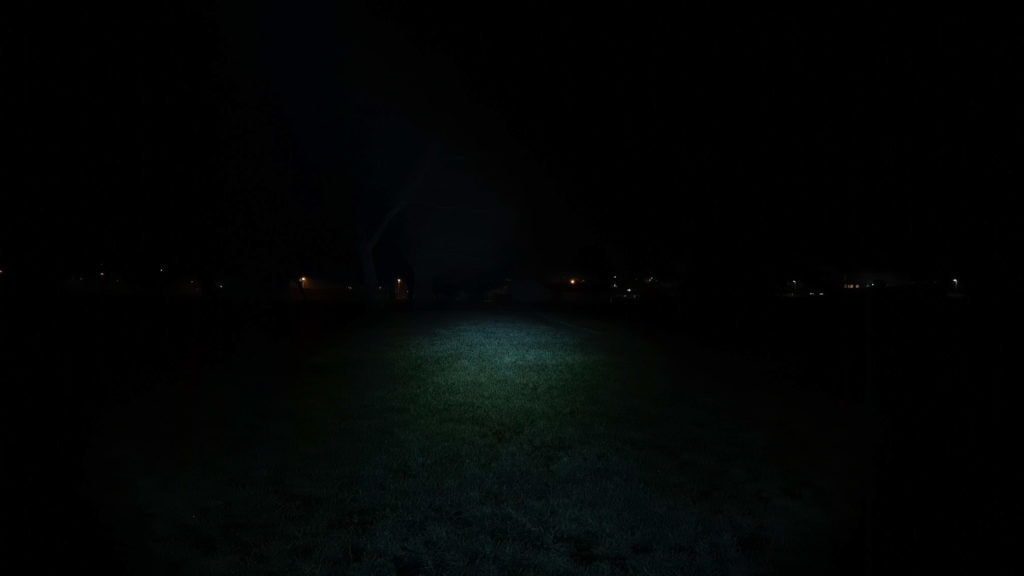
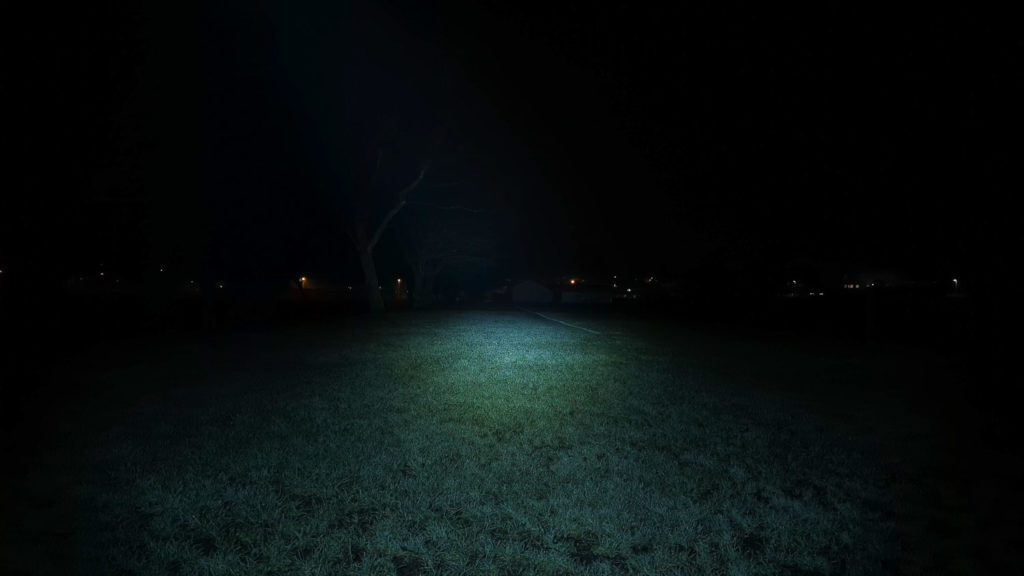
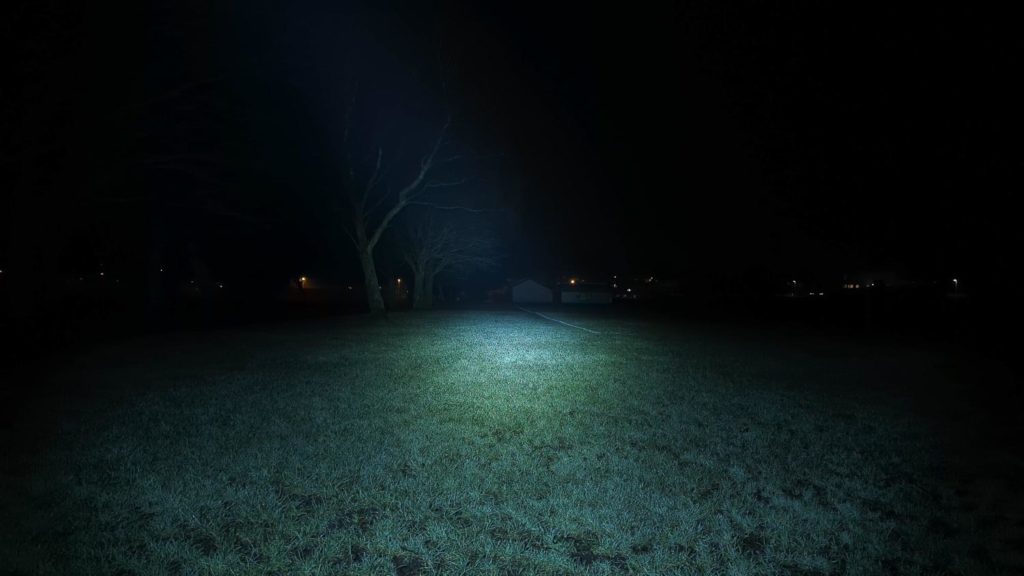
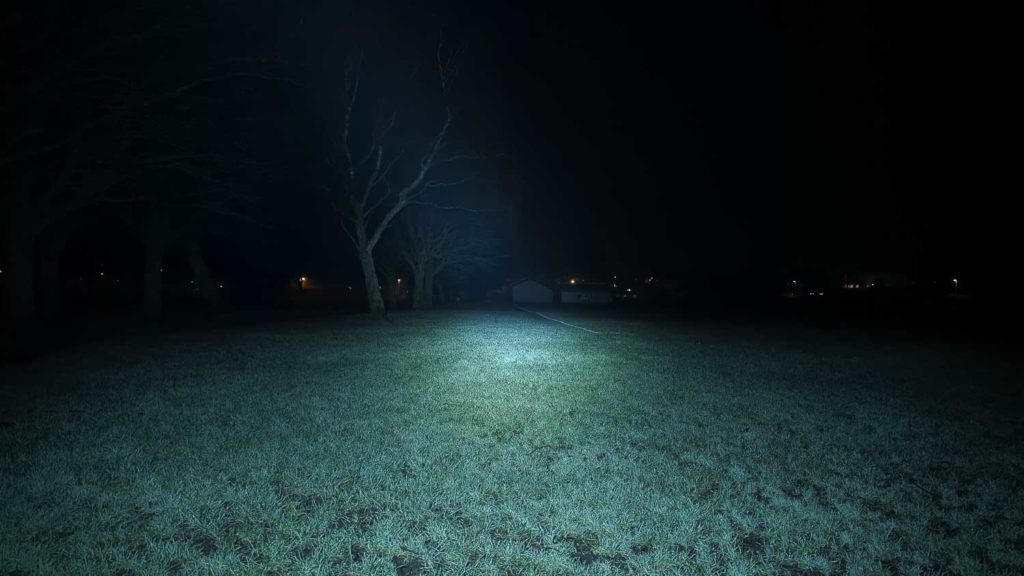
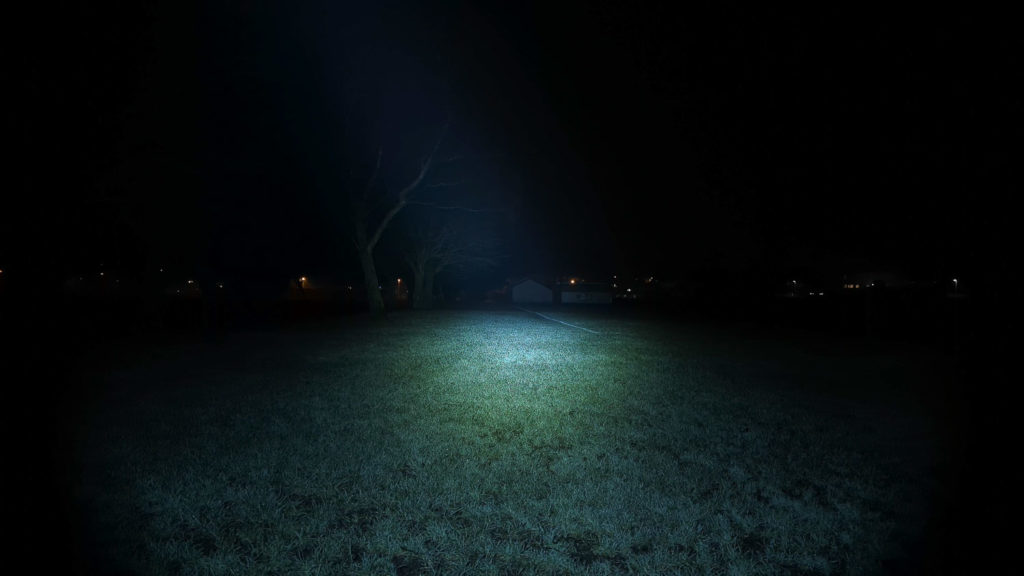
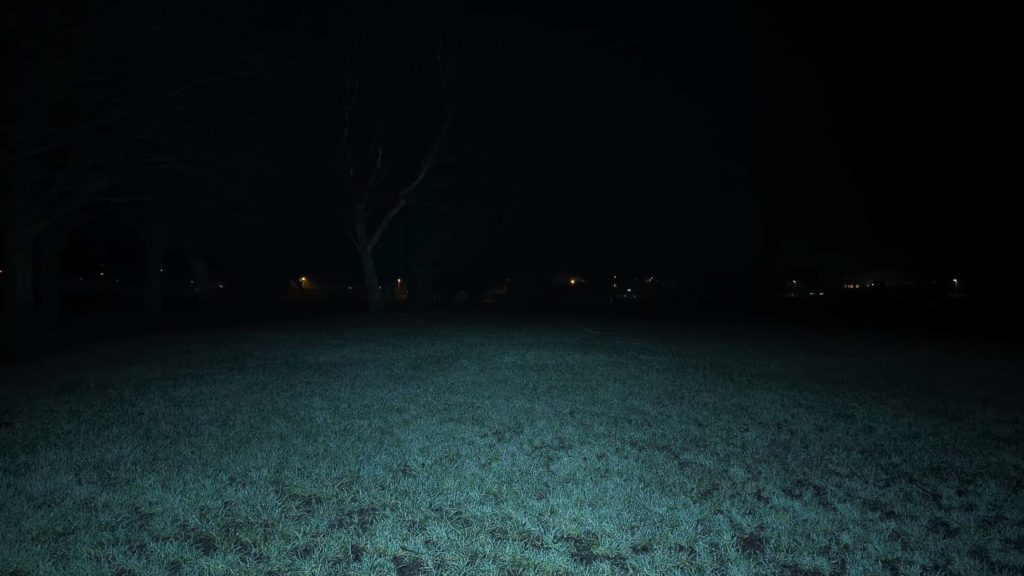
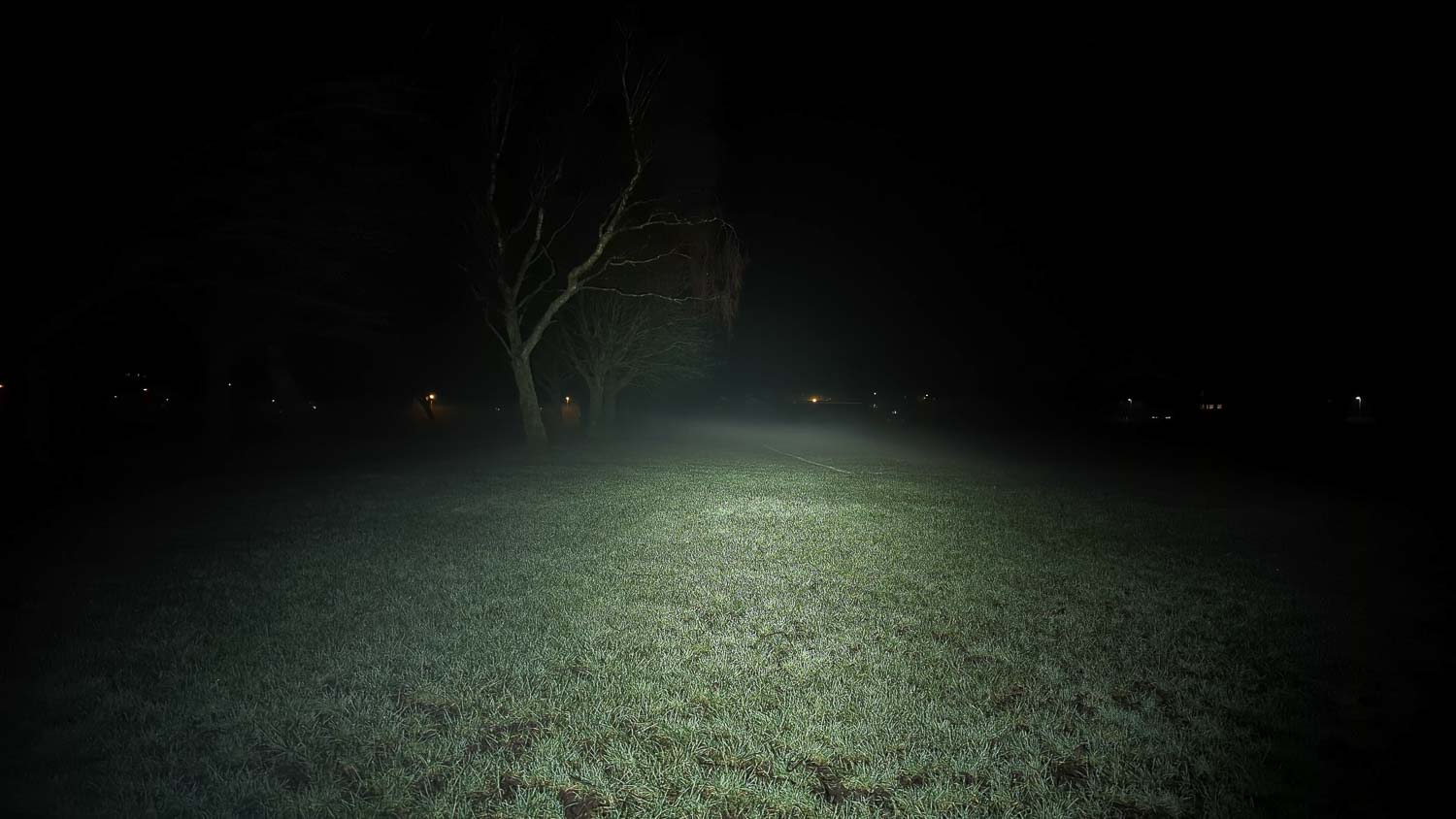
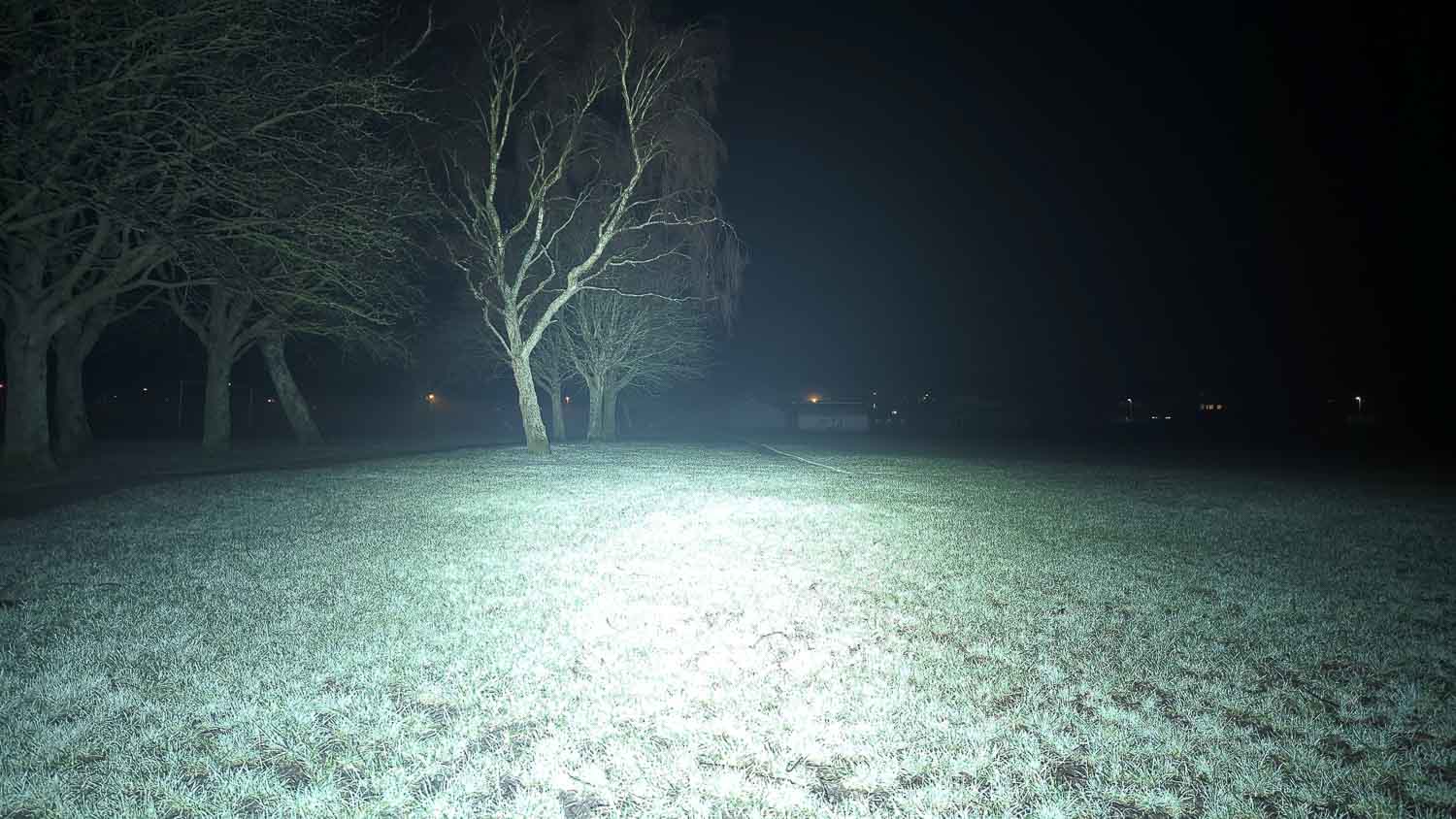

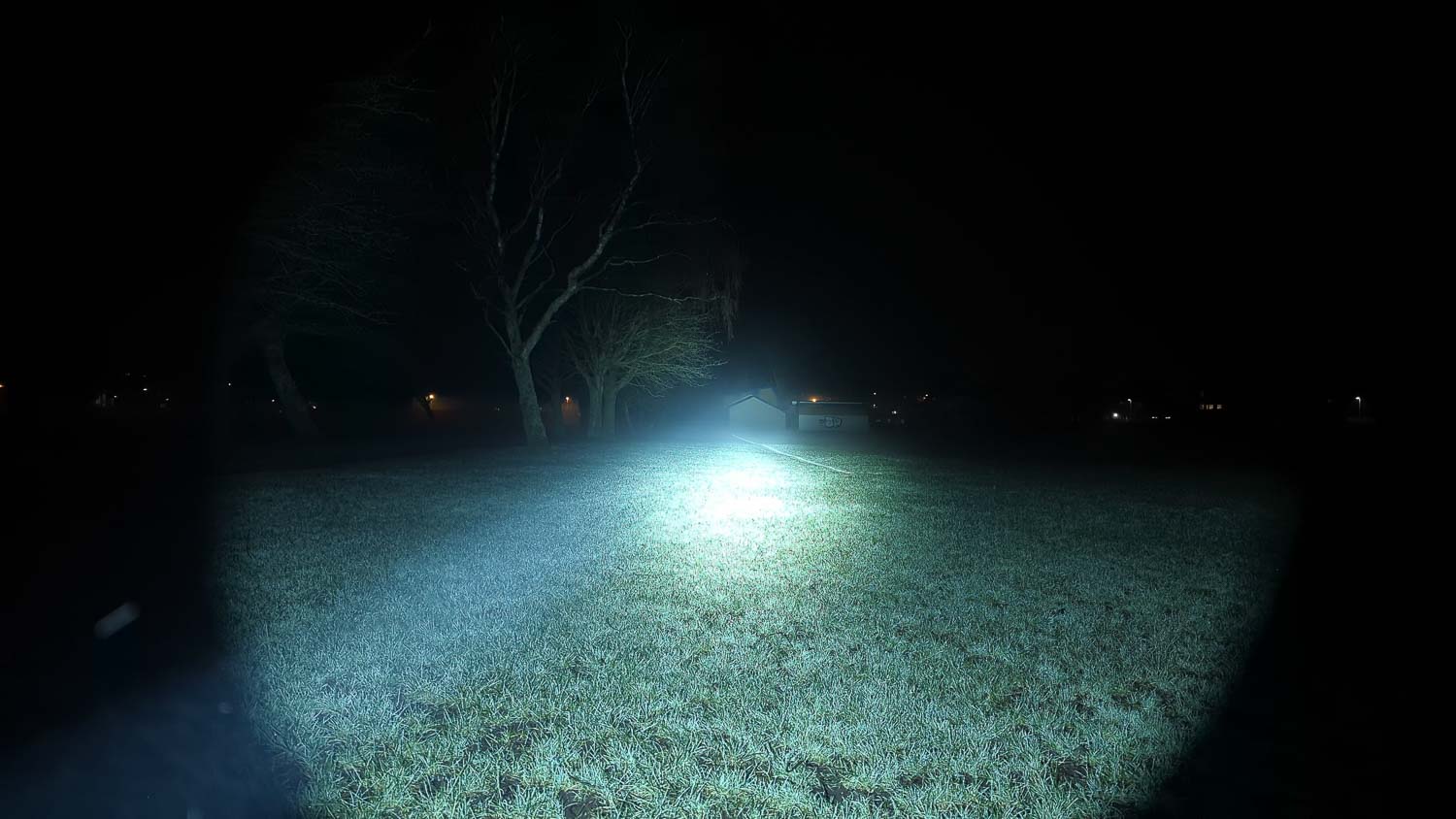
Disclaimer: This flashlight was sent to me for review at no cost by Nitecore. I have not been paid to review, nor have I been holding back on problems or defects.
Final Verdict
Pros
- Twenty thousand lumens!!!
- More pocketable than a soda can light
- Good tactical modes and switches
- Feels incredible solid
- Did I mention that it’s really bright?
Cons
- Doesn’t throw far
- Can’t replace the cells
- Turbo is only about 5 seconds
- Mediocre sustained lumens
Explanation on star ratings:
1: Avoid: my phone flashlight would be a better choice – 2: Poor: significant defect or issues; almost unusable – 3: Average: some defects or issues; but still usable 4: Good: recommended (minor issues) – 5: Great: highly recommended

4.5 stars: ★★★★⋆
I can’t really say no to any light that is brighter or throws further than any other its size. Right now it’s the smallest light that can produce 20,000 lumens. It’s absolutely incredible for its size. It reminds me of the GT Nano and Imalent MS03 as it’s almost unbelievable that something pocketable can produce that much light – for a few seconds at least.
The TM20K hits the sweet spot between single cell size and soda can size flashlight. Depending on the size of your pockets, this might be the Goldilocks light that can double the number of lumens you can EDC. However, if you struggle to carry a single 21700 flashlight then you’re not going to be able to carry this either. For me, the TM20K is the kind of light that’s small enough to take somewhere “just in case”. That means it’s going to get much more use than a flashlight that takes 3 or 4 cells.
Although it lives up to its amazing claims, it’s not without its flaws. Cramming this many LEDs in a light means there’s no room for normal size reflectors, resulting in not as much throw as something with just 1 LED. Having a built in battery pack isn’t perfect either but I’d still expect the cells to last many years.
I don’t know what the retail price will be but no doubt it will be lots more than their 3000 lm tactical lights. The price might be hard to swallow if you don’t intend to use it for short blasts of turbo. If you do need (or want) the lumens then the TM20K is fantastic.
Nitecore TM20K discount code
Get 15% off by using discount code 15OFF on orders above $75. Below $75, use our unique coupon code 1Lumen to get 10% off.
1lumen selects and reviews products personally. We may earn affiliate commissions through our links, which help support our testing.